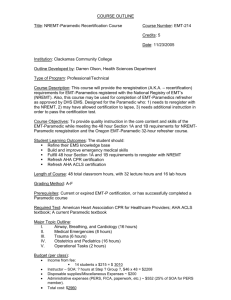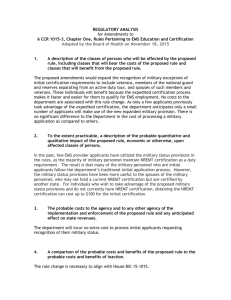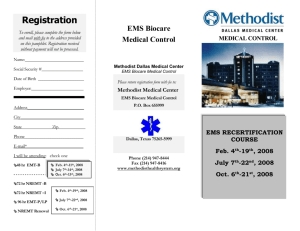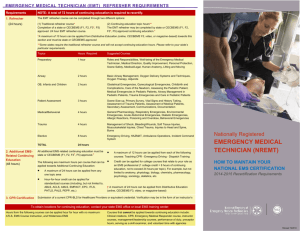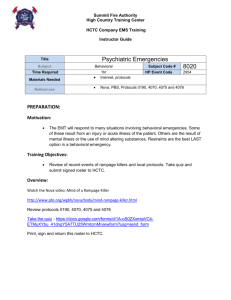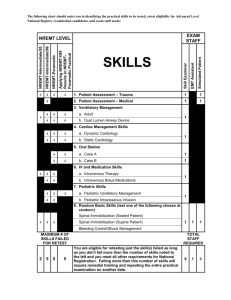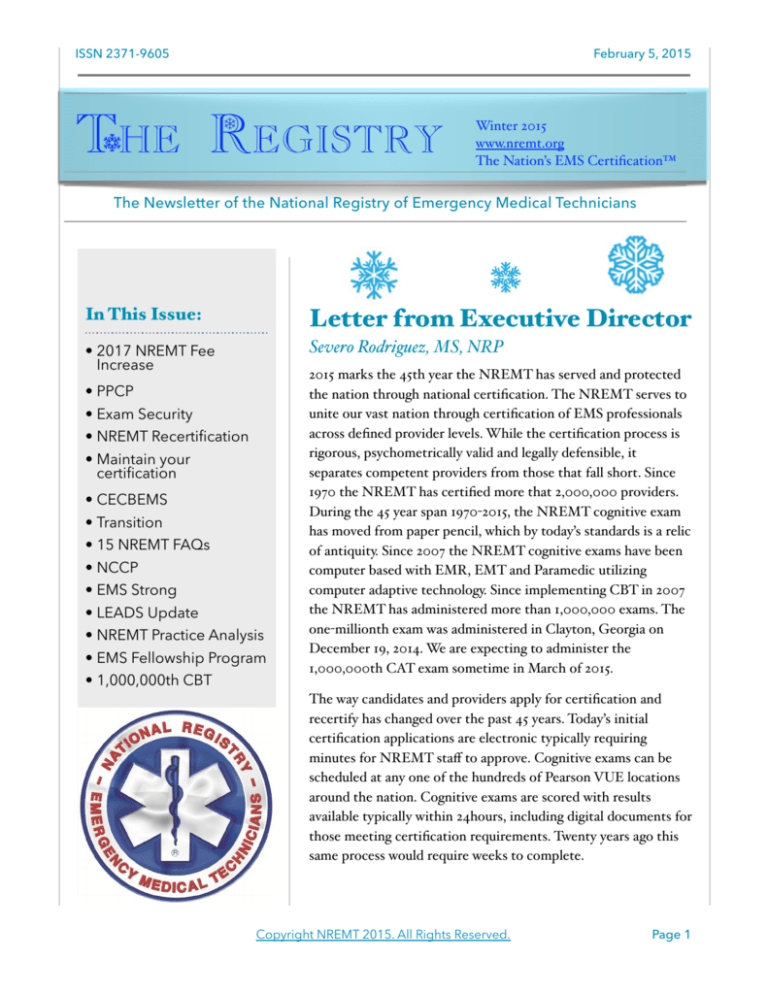
ISSN 2371-9605
February 5, 2015
The Registry
Winter 2015"
www.nremt.org"
The Nation’s EMS Certification™
The Newsletter of the National Registry of Emergency Medical Technicians
In This Issue:
Letter from Executive Director
• 2017 NREMT Fee
Increase
Severo Rodriguez, MS, NRP!
• PPCP
• Exam Security
• NREMT Recertification
• Maintain your
certification
• CECBEMS
• Transition
• 15 NREMT FAQs
• NCCP
• EMS Strong
• LEADS Update
• NREMT Practice Analysis
• EMS Fellowship Program
• 1,000,000th CBT
2015 marks the 45th year the NREMT has served and protected
the nation through national certification. The NREMT serves to
unite our vast nation through certification of EMS professionals
across defined provider levels. While the certification process is
rigorous, psychometrically valid and legally defensible, it
separates competent providers from those that fall short. Since
1970 the NREMT has certified more that 2,000,000 providers.
During the 45 year span 1970-2015, the NREMT cognitive exam
has moved from paper pencil, which by today’s standards is a relic
of antiquity. Since 2007 the NREMT cognitive exams have been
computer based with EMR, EMT and Paramedic utilizing
computer adaptive technology. Since implementing CBT in 2007
the NREMT has administered more than 1,000,000 exams. The
one-millionth exam was administered in Clayton, Georgia on
December 19, 2014. We are expecting to administer the
1,000,000th CAT exam sometime in March of 2015. "
The way candidates and providers apply for certification and
recertify has changed over the past 45 years. Today’s initial
certification applications are electronic typically requiring
minutes for NREMT staff to approve. Cognitive exams can be
scheduled at any one of the hundreds of Pearson VUE locations
around the nation. Cognitive exams are scored with results
available typically within 24hours, including digital documents for
those meeting certification requirements. Twenty years ago this
same process would require weeks to complete. "
Copyright NREMT 2015. All Rights Reserved.
Page 1
ISSN 2371-9605
February 5, 2015
!
(Letter From Executive Director cont.)#
As we look to the future the NREMT will improve the efficiency "
and manner applications and recertifications are reviewed,
validated and processed. Beyond efficiency the future will bring
data and system integration linking providers, states and the
NREMT. While the cognitive exams are a corner piece of the
certification process the psychomotor examination will evolve.
The Paramedic Psychomotor Competency Portfolio (PPCP)
links documented skills performance though the education
program to national certification. The skills portfolio will replace
many of the traditional legacy skills stations and refocus the
remaining to team-based care. "
The future is bright!"
"
NREMT Introduces
Jeremy Miller Certification
Director
1,000,000th NREMT Computer
Based Test Taker - Ryan Curtis,
EMT from Decatur, Georgia
Jeremy Miller is responsible for all
certification functions at the NREMT
including recertification.
During Mr. Miller’s career he has
served as an EMT-Basic, EMTIntermediate and then EMTParamedic. He has worked as a
ground and flight paramedic as well
as a paramedic instructor.
Mr. Miller retired from the Air Force
after 20 years of service. During his
decorated military career he served
as USAF Pararescue Paramedic
Instructor, Flight Chief (Chief
Operating Officer), Senior Enlisted
Advisor for a Joint Task Force and
Director of Air Force EMS. Mr. Miller has experience working
alongside the US Navy and US Army,
both stateside as well as in support
of Operation Iraqi Freedom and
Operation Enduring Freedom.
Welcome Jeremy!
Left to Right - Severo Rodriguez, NREMT Executive Director, Landry
Merkison, Fire Chief, Clayton County Fire & Emergency Services, Keith
Wages, Georgia State EMS Director, Ryan Curtis, EMT - Decatur, Georgia,
Toni Washington, Fire Chief, City of Decatur, E.J. Dailey, Region III EMS
Program Director, State Office of Emergency Medical Services, Ernie Doss,
Deputy Director, State Office of Emergency Medical Services. Copyright NREMT 2015. All Rights Reserved.
Page 2
ISSN 2371-9605
February 5, 2015
NREMT Signs Memorandum of Understanding to Renew Contract
with Pearson VUE, Computer Based Testing Provider
In 2014, the Board of Directors of the NREMT approved a contract renewal with Pearson VUE, NREMT’s computer based
testing provider. The contract will extend the partnership between the NREMT and Pearson VUE through 2021. "
Since 2006, the NREMT committed to freezing its examination fees charged to candidates despite a continued rise in
operating costs for the past ten years. In order to ensure future growth of the Organization, the Board of Directors approved a
fee increase effective January 1, 2017. This will be the first time that the NREMT has
Level
2017
adjusted the cost of its examination in a decade (2007-2017). In addition, the fee
adjustment preserves the NREMT’s continued commitment to administering one of the
EMR
$75
lowest exam fees of all high stakes health career certifications."
As with all of its endeavors, the NREMT’s primary interest is the safety of the American
public. By continuing to utilize computer based testing the NREMT can verify, with
increased precision, that every candidate who passes the NREMT examination possesses
the necessary skills and knowledge to competently provide entry-level, out-of-hospital
emergency medical care. "
EMT
$80
AEMT
$115
Intermediate/99
$125
Paramedic
$125
The NREMT is pleased to continue partnering with Pearson VUE in delivering examinations that provide a fair and precise
evaluation of a candidate’s competency, rapid turnaround of test results, choices on when and where to take the examination,
easy registration and fortified exam security.
Paramedic
Psychomotor
Competency Portfolio
The Paramedic Psychomotor Competency
Portfolio (PPCP) project developed as a result of
requiring graduation from a CAAHEP
accredited paramedic program or one that holds
a current LOR from the Committee on
Accreditation of Educational Programs for the
Emergency Medical Services Professions
(CoAEMSP) for courses that commenced on or
after January 1, 2013. Recognizing the rigorous,
consistent review of paramedic programs
through the accreditation process, the NREMT
began to investigate revision of our paramedic
psychomotor examination. The NREMT
focused on a more scenario-based examination
that could also incorporate essential attributes of
team leadership and team membership, thus
better reflecting actual out-of-hospital care as
opposed to continuing to test 12 isolated skills.
The NREMT developed a portfolio of vital skills
that each paramedic student must master in
!
!
!
!
!
!
!
!
!
order to qualify for the National Registry
Paramedic Certification examination. Each
student’s portfolio is tracked by the program
throughout the formative and summative phases
of education in the classroom, laboratory,
clinical, and field internship settings. The
completed portfolio becomes a part of the
student’s permanent educational file and is a
prerequisite to seeking National Registry
Paramedic Certification."
The NREMT anticipates incorporating the
scenario-based examination in several phases,
with Phase 1 beginning on August 1, 2016. In
this first phase, a total of six (6) skills will be
tested, five (5) of which are currently evaluated in
the National Registry Paramedic Psychomotor
examination. One scenario will also be tested
and it could reflect either a pediatric, geriatric,
or adult patient. A trained paramedic partner
will be supplied as part of the examination team
and will serve as the candidate’s professional
partner. Each candidate will be evaluated in his/
her ability to manage a call, lead the team, direct
all personnel and resources on scene, effectively
communicate, and maintain professionalism
throughout the call.
The six (6) skills that will comprise the National
Registry Paramedic Psychomotor examination
effective August 1, 2016, are as follows:"
1."
Patient Assessment – Trauma "
2."
Oral Station – Case A"
3."
Oral Station – Case B"
4."
Dynamic Cardiology"
5."
Static Cardiology"
6."
Out-of-hospital Scenario"
Please visit this link (http://tinyurl.com/
NREMT-PPCP) for documents and essays used
during the laboratory, clinical, and capstone
phases of a student’s education. Students and
educational programs are welcome to use these
documents for non-commercial purposes of
educational or scientific advancement."
Copyright NREMT 2015. All Rights Reserved.
Page 3
February 5, 2015
Examination Security
Thoughts on Integrity, Honesty, Certification & Licensure!
by Rob Wagoner, BSAS, NRP, Senior Director of Quality and Standards!
s
ric
et
t
Today, certification by the NREMT forms a significant basis upon
which most states issue a license to practice as an EMS
professional. Licensing is a process by which a government agency
grants individuals permission to engage in a specified profession or
occupation upon finding that individual applicants have attained
the minimal degree of competency required to ensure that the
public’s health, safety and welfare will be reasonably well
protected.3 Licensure is intended to protect the public by
screening out individuals who would do harm and disciplining those
who have inflicted harm. Over the years, the public has become
more accustomed to and more accepting of licensing as a restriction
needed to protect society from incompetents. A resultant licensure
action, based upon a compromised certification process, could very
likely result in death, disability, or permanent harm to many of the
patients who are treated by EMS providers in the high-stakes, outof-hospital environment."
ten
Although the days of paper-pencil testing have been replaced with
computer adaptive and linear testing, some candidates continue to
engage in similar unscrupulous activity to this day. In fact, all high
stakes examination sponsors are under increasing challenges to
develop and deploy contemporary methods of surveillance and
detection in an effort to assure that the examination results upon
which the pass/fail decisions are based are accurate, authentic, valid
and truly representative of that candidate’s abilities. Partnering
with Pearson-VUE to deliver our computer-based examinations
beginning in 2007 dramatically improved examination security and
provided greater precision upon which we make the pass/fail
decision. Unfortunately, though, unscrupulous activity by some
who show no regard whatsoever for the policies and procedures of
the NREMT, as well as a severe lack of ethical and moral standards,
continue to attack the very core of our certification program: the
standards, policies, procedures, assessment instruments, and related
products and activities through which individuals are publicly
identified as qualified in a profession, occupation, role, or skill.2"
Validity Triangle
n
Co
The rationale behind the National Registry examination is
that . . . questions selected at random . . . will adequately
measure the candidate’s overall competence. The rationale
fails in its goal when a candidate anticipates the questions
which will appear on the examination and focuses his or her
study efforts on those questions to the exclusion of the
remainder of the curriculum. The National Registry has a
legitimate concern about the plaintiff ’s competency to be
certified as a paramedic. Plaintiff ’s efforts to reconstruct
the examination can fairly be characterized as misconduct
within the meaning of the National Registry’s disciplinary
procedures. The National Registry has the right to cancel
that exam score if, in its sole opinion there is adequate
reason to question its validity."
The validity of scores, that is the degree to which accumulated
evidence supports specific interpretations of all components of a
certification program (education, experience, and assessment
instruments)4, is as important today as it was when we defended
our processes over 20 years ago. Recently, Philip Dickison, PhD,
RN and Chief Officer of Examinations for the National Council of
States Boards of Nursing presented the following framework to
view examination results from a measurement perspective as
opposed to the behaviors of test takers:5"
om
Over 20 years ago, the NREMT was sued by a candidate when we
refused to score or report examination results.1 Shortly after
completing the NREMT-Paramedic written examination, a
notebook was discovered that contained over 100 individual entries
that in some cases were almost verbatim copies of copyrighted
NREMT examination items. Although the NREMT offered to readminister a different series of the NREMT-Paramedic
examination at no additional charge and reimburse the candidate
for the notebook left behind, the candidate refused to retest and
sought legal action against us. After hearing the case and reviewing
the evidence, Judge Graham wrote the following in his findings:"
Ps
yc
h
ISSN 2371-9605
Security
Dr. Dickison identifies three interrelated components
that must be assured throughout the entire testing
continuum in order to produce valid results upon which
the most critical certification and licensure decisions are
based. Whenever one or more legs of the triangle
becomes weakened or damaged, it is no longer the
strongest geometric shape that it once was. The
NREMT certification process has evolved over the past
45 years to incorporate computer adaptive testing (CAT)
and other contemporary psychometric processes;
partnered with Pearson-VUE, one of the world’s largest
deliverers of electronic assessments, to improve security
and biometric identification of candidates; and continues
to involve all EMS communities of interest to participate
in a facilitated item writing process that results in the
addition of several thousand contemporary items each
year."
The time is long-overdue for all professionals in our
communities of interest to understand the roles each of
us play and the influences we have in the “Validity
Triangle.” There is perhaps no higher stakes occupation
than EMS when you consider the length of education,
practice setting, age of the provider, and potential for
time-sensitive, life-saving decisions that we expect be
correctly carried out on every call. Who will be the voice
for the patients who never realized that their next breath
could be in the hands of a responding EMS provider?
Shouldn’t that patient expect to be served by a
competent provider who earned his or her certification
and state licensure only through honorable means? !
REFERENCES 1.
MacKenzie vs. The Na1onal Registry of Emergency Medical Technicians, United States District Court for the Southern District of Ohio, Eastern Division, Case No. C2-­‐91-­‐174, Dec. 6, 1991. 2.
Knapp, Joan et al, Basic Guide to Creden1aling Terminology, Ins1tute for Creden1aling Excellence, October 2006. 3.
Shimberg, Benjamin and Roederer, Doug, Ques1ons A Legislator Should Ask, 2nd Edi1on, The Council on Licensure, Enforcement and Regula1on (CLEAR), 1994, p. 1.
4.
Knapp, Joan et al.
5.
Dickison, Philip, “Unlocking the Mystery of the Validity Triangle,” Caveon Webinar Series, Nov.
19, 2014. !
Copyright NREMT 2015. All Rights Reserved.
Page 4
ISSN 2371-9605
February 5, 2015
JOB #1 – MAINTAIN YOUR NREMT CERTIFICATION
Maintain your NREMT certification!
You’ve worked hard to obtain your NREMT certification…now maintain it! How many times did you say after you
obtained your NREMT certification, “I’m never taking that exam again!” I know that I did. !
Well, now it’s time to recertify. I’m sure many of you are asking, “Why should I maintain my NREMT?” Maybe
you should ask yourself, “What are you going to be doing in 5 years and where will I be living?” If you can’t answer
these questions, it’s probably a good idea to maintain your NREMT certification.
KEEP IT SIMPLE --- KEEP IT UP!
I can’t tell you how many times I’ve heard from EMS providers that they should never have let their NREMT
certification lapse. A lot of times providers obtain their initial certification and then let it lapse once they
receive state certification or licensure. The problem arises when a registrant allows his/her NREMT
certification to lapse and then seeks employment in another state without current National EMS
Certification. In most states, the only way to obtain state certification or licensure is to present a current
NREMT certification. What do you have to do now? It’s simple: complete refresher training, show proof of a
few courses and take your written (cognitive) and psychomotor (skills) exam all over again (link to lapsed
certification). Yep, in order for you to now apply for that new job in another state, you will more than likely
have to go through the initial NREMT certification process over again. !
MAINTAIN IT --- DON’T REGAIN IT!
My recommendation is to maintain your NREMT certification…don’t put yourself in that situation of having to
regain your NREMT certification. Plus, those NREMT credentials behind your name indicate you have been
certified to the national EMS competency level. All of us who hold NREMT certification are proud of what we
have achieved and we have all met the same competency standards for cognitive knowledge and psychomotor skills. !
The NREMT accepts many forms of continuing education (CE). Please take the time to review our certification
brochures for guidance on acceptable CE.
RBE – Recertify By Examination
Oh and don’t forget that you can recertify by exam. Yep, that’s right, take that cognitive (written)
exam all over again. I have and it’s not that bad. If for some reason you are not successful, you don’t
lose your NREMT certification, you simply have to submit all applicable recertification requirements
by the deadline in order to recertify. If you need to transition as well, this is a great option for that…if
you are successful on the recertification by examination you automatically transition as you have been
tested on the new national education standards.
Lastly, did you know that you can go to an “Inactive” status with the NREMT? Yes, if you are currently not affiliated with an EMS agency,
for example, don’t have a training officer or MD to sign off on your application, you can go inactive. Simply submit your NREMT
recertification application and check inactive. In order to go to an “Inactive” status, you must show proof that you’ve worked in a
volunteer or paid capacity at your level of National EMS Certification for a minimum of 6 months within that initial certification period.
In order to return to “Active” status, print off a request form (Inactive to Active) have your new training officer and MD sign off on the
skills section, send it in and we’ll update your account. !
Should you have any questions about any of these processes, please visit our website and/or call the NREMT at 614-888-4484, option # 2. !
Best of luck with your NREMT recertification this year! !
Gabe Romero, MBA, NRP, Director of Examinations
Copyright NREMT 2015. All Rights Reserved.
Page 5
ISSN 2371-9605
1
!
!
!
!
3
February 5, 2015
Top 15 NREMT
FAQs
!
When should I arrive at the Pearson VUE test center
to take my CBT exam? !
You should plan to arrive at the test center at
least 30 minutes before the scheduled testing
time. The identification and examination
preparation process takes time. You may also
need this time to review the tutorial on taking a
computer based test. !
My NREMT certification has lapsed. How can I gain my
certification back? !
If your certification has expired within two years of
the expiration date or you are state licensed at the
level you want to test, you will need to complete a
state approved refresher, NREMT cognitive and
psychomotor exams. If your NREMT certification
has lapsed beyond two years and you are not
licensed at the level you want to test, please contact
the NREMT for entry requirements.
5
6
7
8
How can I affiliate with an Agency?!
Log into your NREMT account, click
‘My Certification.’ Click on the
‘Unaffiliated’ link and follow the
steps to finish selecting your agency.
To see if you’ve been affiliated with
your agency, look in the upper left
corner. If the agency you work for
appears under your NREMT number,
you are successfully affiliated.
What are the current recertification requirements?!
Please click on the level you wish to view:!
Emergency Medical Responder, Emergency
Medical Technician, EMT-Intermediate/85,
Advanced EMT, EMT-Intermediate/99,
Paramedic
!
!
!
2
4
I’m having trouble with my username and password on the
NREMT website.!
If you know your username you can reset your
password on the NREMT website by clicking the
“Forgot Password” link. If you need both username
and password, you can use the automated phone
system by calling the NREMT at 1-614-888-4484 and
choose option #1.
How do I apply; pay and schedule to take the
NREMT cognitive exam?!
There are step-by-step instructions on
setting up an application, paying your fee
and scheduling your exam on our
homepage (www.nremt.org). Look for the
link “Follow These Steps to Apply for Your
NREMT exam.”
What does the NREMT accept as valid continuing education? !
The NREMT accepts continuing education that has received
official approval through your State EMS office and/or the
Continuing Education Coordinating Board of Emergency
Medical Services (www.cecbems.org). Continuing education
topics may include subject matter contained within the
National Scope of Practice as well as other subject matter
specifically related to the emergency medical care of patients.
Continuing education may be obtained through a variety of
delivery methods including didactic sessions, practical drills,
workshops, EMS conferences, and distributive education.
Who can sign the skills portion of the recertification form?!
Emergency Medical Responder (EMR): Your Training Officer/
Supervisor can sign the skills portion of the form.!
Emergency Medical Technician (EMT) and Intermediate/85: Your
Training Officer/Supervisor can sign the skills portion of the form.!
Intermediate/99, Advanced EMT and Paramedic: You’re Physician
Medical Director must sign the skills portion of the form.
Copyright NREMT 2015. All Rights Reserved.
Page 6
ISSN 2371-9605
February 5, 2015
Top 15 NREMT FAQs
9
11
10
Where do I go on the NREMT website to find my CBT
(cognitive) exam results? !
Log into your NREMT account and click on
“Check Initial Entry App Status.” In most
cases your results will post to your NREMT
account within 1-2 business days.
How do I locate an Advanced Level Psychomotor
exam so that I can test?!
On our homepage (www.nremt.org) click
“Locate a Psychomotor Exam.” Select the
state where you would like to test and then
select the appropriate level. Then click the
“binoculars” icon next to the exam to see full
details.
13
15
12
I took my Advanced Level Psychomotor Examination
this weekend. Where are my results? !
Your official results will be reported to you by
mail in approximately three to four week as
pass/fail of the skills tested only if you have
created an account at the level you are testing.!
14
When I complete my recertification online, do I still need
to mail my documents to the NREMT? !
If you are affiliated with an Agency and have
submitted your application electronically, do not
print and mail your documents to the NREMT.
Your Training Officer and Physician Medical
Director (if applicable) will electronically sign
your form and your application will be
automatically forwarded to the NREMT. We
recommend you print and save a copy for your
personal records. !
Why haven’t my Advanced Level Psychomotor results
been processed?!
You must have a completed electronic application
for the level at which you tested on file in order
for the NREMT to process and mail your official
results.
I heard that there was an Advanced Level Psychomotor
Examination being held in a city near me this weekend.
What do I need to do to be sign up for that exam? !
You are unable to sign-up for this exam. The
NREMT ships only enough exam material for those
candidates identified on the roster three weeks
before the exam date.
What two forms of IDs are acceptable when I go to test? !
The first ID must be an unexpired, government-issued
ID that includes a signature and permanently affixed
photo (visible signature not required for valid military
IDs). !
Acceptable government issued ID:!
•!
!!
State Issued Driver’s License!
(temporary/paper
ID will not be accepted)!
!
•!
•!
•!
State Issued Identification Card!!
Military Identification Card!
Passport!
!
!
The second ID must be unexpired and include your
name and signature. Examples of an acceptable second
ID include:!
•!
•!
!
U.S. Social Security card!
!
Bank ATM/Debit or credit cards!
!
Your name on both forms of ID must be exactly the
same as the name on record at the NREMT and on
your Authorization to Test letter. If you have
questions regarding the acceptability of you IDs,
please contact Pearson VUE before arriving at the test
center. !
Copyright NREMT 2015. All Rights Reserved.
Page 7
ISSN 2371-9605
February 5, 2015
The National Continued Competency
Program: The “New” Recertification Model
Since the 1980s, national EMS recertification has consisted
of 72 clock hours of continuing education for each
nationally certified EMS provider level. Recently, the EMS
community across the nation has been changing entry
requirements with the adoption of the new National EMS
Scope of Practice and implementation of the EMS
Education Guidelines. Because entry level requirements
have changed, it was necessary to evaluate continued
competency requirements.!
by the NREMT Board of Directors and will be updated
every five years. After content has been selected,
educational materials will be developed and disseminated
to training officers, medical directors and program
directors free of charge. !
In 2012, the NREMT introduced a new recertification
model, the National Continued Competency Program
(NCCP). Constructed using methodology similar to that
of the American Board of Medical Specialty requirements,
the new NCCP model streamlines the recertification
process into three strategic categories of continuing
education: National, Local, and Individual. !
The local component of the NCCP will constitute 25% of
the new recertification requirements at each level. The
requirement for these hours will be decided by local
entities, including the state, region or agency. These topics
can include state or local protocol changes, tasks that
require remediation based on QA/QI and topics chosen
from run reviews. The local component allows national
recertification requirements to be adapted to the needs of
the state and local agencies. Methods to provide current
continuing education such as monthly training,
conferences, and in-service training will stay the same.!
The NCCP offers numerous improvements that will
impact EMS for the better for years to come. These
changes allow a platform for evidenced-based medicine to
reach EMS professionals all over the country, give state and
local agencies the freedom to dictate a portion of the
recertification requirements and provide a foundation for
the EMS professional to embrace life-long learning through
self-assessment. !
Finally, the individual component of the NCCP will
constitute the last 25% of the new recertification
requirements at each level. Within this component, an
individual is free to take any EMS-related education. New
to this recertification model will be a self-assessment tool.
This self-assessment tool will provide feedback and
recommendations for individual learning needs for the next
recertification period. !
The national component of the NCCP will constitute 50%
of the new recertification requirements at each level and
will replace the traditional DOT refresher. Topics will be
updated and will reflect current trends in evidence-based
medicine, scope of practice changes and position papers
from numerous associations involved with EMS research.
It will also focus on those patient presentations that have a
low frequency but high criticality. The national
component will be developed by a panel of experts assigned
As a result of the new NCCP recertification model, the
total continuing education hours needed to recertify a
national EMS certification have been reduced for EMTs,
AEMTs and Paramedics (Table 1). As this model is
implemented throughout the country, more information
regarding the transition to the new recertification model
will be provided. !
Table 1. NCCP CE Hour Requirements by Level (Every 2 Years)!
National (50%) Local (25%) Individual (25%)
Total Hours
Paramedic
30
15
15
60
AEMT
25
12.5
12.5
50
EMT
20
10
10
40
EMR
8
4
4
16
Copyright NREMT 2015. All Rights Reserved.
Page 8
ISSN 2371-9605
February 5, 2015
CECBEMS - What is CECBEMS?
The Continuing
Education
Coordinating Board
for Emergency
Medical Services
(CECBEMS) is a
continuing education
(CE) accreditation
service whose volunteer
Board of Directors is made up of liaisons from each of
the national EMS leadership organizations including
ACEP, NAEMT, NAMESP, NASEMSO, ACOEP,
NAEMSE, AHA and NREMT. CECBEMS reviews
accreditation applications from CE providers on a
national and international scale. !
Founded in 1992, CECBEMS' mission is to serve as
the recognized leader for CE in EMS, promoting its
evolution and growth through development of CE
standards, encouragement of innovative learning
solutions, the support of continuous learning
opportunities and the assurance of optimal learning
experiences to prepare all EMS providers for their
professional challenges. !
EMS providers can in turn seek out accredited
continuing education hours that they know meet or
exceed accepted standards. Thus, the time and
expense invested in continuing education and of
maintaining licenses and credentials isn't wasted on
CE hours that may later be rejected by State or
National regulators. !
CECBEMS’ goal is to improve the quality of, and
opportunities for, CE for our nation's EMS providers
who work tirelessly, often under austere conditions, to
help their communities in times of need. CECBEMS
seeks to improve access to excellent educational
opportunities for EMS providers who often are
limited by their work schedules and financial
constraints to maintain their credentials through CE.
For more information, please visit www.cecbems.org.
The NREMT continues its commitment to the implementation
of the National EMS Scope of Practice Model. For some, the
deadline is here. Does this affect you?
First Responder Expires:
Complete EMR Transition by:
NREMT - Basic Expires:
Complete EMT Transition by:
September 30, 2011
September 30, 2015
March 31, 2011
March 31, 2015
September 30, 2012
September 30, 2016
March 31, 2012
March 31, 2016
NREMT - Intermediate/85 Expires:
Complete AEMT Transition by:
March 31, 2012
March 31, 2016
NREMT - Intermediate/99
Expires:
Complete Paramedic
Transition by:
March 31, 2013
March 31, 2017
March 31, 2012
March 31, 2018
March 31, 2013
March 31, 2019
NREMT Paramedic Expires:
Complete Paramedic Transition by:
March 31, 2012
March 31, 2016
March 31, 2013
March 31, 2017
Copyright NREMT 2015. All Rights Reserved.
Page 9
ISSN 2371-9605
February 5, 2015
NEW CAMPAIGN LAUNCHED TO INSPIRE AND
UNITE THE EMS COMMUNITY
The EMS STRONG campaign has launched, complete with a new website, revamped EMS WEEK
commemorative guide, and a commitment to celebrating what really matters – the men and women of EMS
– 365 days a year.
The new website, www.emsstrong.org, will serve as a hub of inspiration and content for first responders.
The site contains stories, information on health and mental wellness, resources and templates for
promoting EMS WEEK and much, much more.
For more information on the campaign, click here. (link to emsstrong.org)
NREMT- LEADS Update
The NREMT Research Department Presents Posters at National
Association of EMS Physicians Conference!
On January 15, 2015 the NREMT Research Director and EMS
Research Fellow presented four posters at the annual meeting of
the National Association of EMS Physicians (NAEMSP) in New
Orleans, LA. Three posters were based on data collected as a part of
the ongoing Longitudinal EMT Attributes and Demographics Study
(LEADS). !
census survey, centered on patient care feedback in the out-ofhospital setting. The most common type of feedback was on
medical care provided, which only about half (55%) of EMS
professionals received. Least common was feedback on patient
satisfaction, received by less than a third (32%) (See Figure 1). The
sources of feedback (immediate supervisor, partner or crewmember,
staff at the receiving facility, Medical Director, and Training Officer
or Quality Improvement Officer) and modes (verbal, e-mail, texting,
Figure 1. Prevalence of Feedback Provided to EMS Professionals by Type
The first poster used data from the 2004 and 2014
LEADS longitudinal questionnaires to compare
ambulance collisions and safety habits from today to
those of 10 years ago. The authors found that the
number of collisions involving ambulances has remained
relatively constant; however the severity may be
decreasing as fewer EMS professionals required medical
attention after being involved in a collision. Further,
more EMS professionals are using seatbelts in the
patient compartment, yet, even today, less than a third
are doing so consistently. !
The second poster, based on data from the 2013 LEADS
Copyright NREMT 2015. All Rights Reserved.
Page 10
ISSN 2371-9605
February 5, 2015
LEADS Update cont.
Next, a look at the cardiovascular health of EMS professionals
revealed that only about 6% had ideal (versus intermediate and
poor) health in all six of the components that were examined. EMS
providers were more likely to have ideal cardiovascular health in
specific components including fasting glucose (71%), cholesterol
levels (69%), and smoking (64%). Conversely, EMS professionals
were more likely to be classified as poor cardiovascular health in the
BMI (33%) and physical activity components (36%).!
The final poster was based on data collected as a part of the
paramedic practice analysis and aimed to describe the practice of
Mobile Integrated Healthcare Providers (MIHPs). MIHPs were
found to perform more non-emergency or scheduled tasks than
traditional paramedics including psychosocial needs assessments
and coordinating care with patients’ nurses or physicians. The
complete abstracts can be found in the January/March 2015 edition
of Prehospital Emergency Care. !
EMS Fellowship Course
evaluate their competency. The program draws
on the expertise of a unique blend of faculty who
have an expertise in the regulatory environment
(Alex Isakov, MD, Douglas Kupas, MD, Lee Smith,
JD, MD, and Keith Wages), EMS education (Debra
Cason, David Page), and testing/certification
(Severo Rodriguez, Rob Wagoner). Feedback
from the participants was again very positive and
plans are already underway for the 2015 EMS
Fellows Educational Program in Atlanta, GA.
Announcements are forwarded to all EMS
Fellowship Directors and limited space is available
for EMS Fellows on a first come, first served
The NREMT was pleased to co-sponsor and
support the fourth annual EMS Fellows
Educational Program in Atlanta, GA on Dec. 15 –
16, 2014. Alex Isakov, MD, Emory University
School of Medicine, worked with Severo
Rodriguez, NREMT Executive Director to facilitate
planning, financial support, and execution of
another successful program. A total of 20 EMS
Fellows from around the country participated in
this program that was designed to prepare future
EMS medical directors to examine their regulatory
environment, to educate EMS professionals and to
basis.
The 2014 National EMS Practice Analysis
What is a practice analysis?!
A practice analysis is a necessary process that guides the test development process of our cognitive exams. Every 5
years the NREMT gathers data from randomly selected nationally certified EMS providers from every state
through an electronic questionnaire. This questionnaire’s main focus is to assess the frequency and severity of
calls EMS providers encounter. Specifically, we look at low frequency high criticality as a point of measure when
reviewing these data. For example, a pediatric cardiac arrest in an infrequent call, which would equate to low
frequency, but the call has high criticality because of the type of procedures that must be completed during
resuscitation. !
What do we do with the data?!
After data collection, an analysis is conducted that takes into account weights for frequency and criticality. This
weighted importance score is then combined for each of the five domains on the NREMT examinations; Airway,
Respiration & Ventilation, Cardiology & Resuscitation, Medical & OB/Gyn, Trauma, and EMS Operations. After
the weighted importance scores have been added up, the proportion represented by each area tells the NREMT
what percentage each domain should constitute. These data then set the blueprint for the next five years of
NREMT examinations. !
This happens because of you!!
For those of you who were randomly selected and participated, THANK YOU! Your specific EMS expertise was
invaluable to this project. By answering questions on this survey, and all EMS research surveys from our office, you
contribute to improving our profession. Once again, THANK YOU!!
Copyright NREMT 2015. All Rights Reserved.
Page 11
ISSN 2371-9605
February 5, 2015
2015 NREMT Test Plan Change
In order to continue to meet the requirements of the National Commission for Certifying Agencies
(NCCA) accreditation (www.credentialingexcellence.org), the NREMT recently completed its fifth
practice analysis. Every five years, an appropriate sample of nationally certified EMS professionals at all
levels is selected and surveyed. Respondents who provide care in the out-of-hospital setting provide
feedback on patient assessment, treatment and operational tasks as well as various intervention skills.
Participants identify the frequency at which they perform these tasks as well as identify the potential of
harm associated with each task. A weighted importance score (WIS) is calculated based on all responses
and the relative importance of each task is then determined. Demographic questions were also included
in the survey to help assure that the respondents were representative of all nationally certified EMS
professionals. !
The NREMT Practice Analysis Committee met in September 2014 to review the results of this study
and develop a Test Plan reflective of this most recent survey of data. The demographic makeup of the
respondents were analogous to the current NREMT database and other NREMT initiatives (previous
research efforts and Practice Analyses). The proposed test plans were then presented to the NREMT
Board of Directors at their November 2014 meeting and were approved for implementation on
September 1, 2015. !
Beginning on September 1, 2015, all NREMT Test Plans and reported results will be based on the
revised test plans as shown below (Table 1). It should be noted that the maximum number of items
delivered and the maximum time limits for each of the current computer based NREMT cognitive
examinations will remain unchanged by these revised test plans. Only the emphasis of particular tasks
has changed, not the items or standards for entry-level competency. !
Table 1
Content Area
EMR
(90- 110 items)
EMT
(70 - 120 items)
AEMT
(135 items)
Paramedic
(80 - 150 items)
Airway, Respiration & Ventilation
(85% adult / 15% pediatric)
18% - 22%
18% - 22%
18% - 22%
18% - 22%
Cardiology & Resuscitation
(85% adult / 15% pediatric)
20% - 24%
20% - 24%
21% - 25%
22% - 26%
Trauma
(85% adult / 15% pediatric)
15% - 19%
14% - 18%
14% - 18%
13% - 17%
Medical/Obstetrics/Gynecology
(85% adult / 15% pediatric)
27% - 31%
27% - 31%
26% - 30%
25% - 29%
EMS Operations
11% - 15%
10% - 14%
11% - 15%
10% - 14%
Copyright NREMT 2015. All Rights Reserved.
Page 12

